PRACTICAL APPLICATIONS
Bamboo shoots are low in fat and high in carbohydrate, potassium, dietary fibres, iron, phosphorus, vitamins and active materials that are gaining popularity worldwide for utilization as healthy and nutritious foods. The young shoots, after fortification, can be consumed by processing into a wide range of food products with longer shelf-life and better organoleptic qualities. It is because of the virtue that we have done the analysis of different parameters so that the bamboo becomes the part of the daily diet of not only the peoples but also the less privilege society living in villages. Therefore, the present research provides a great opportunity, especially for the food processing sector to take up the processing of bamboo shoot-based food products in daily diets in an organized manner with their consumption pattern and the quality attributes along with future prospects in the international markets.
INTRODUCTION
Bamboos have a long history of being versatile and a widely used bio-resource. Bamboos belong to the tribe Bambuseae of the family Poaceae. A total of about 128 species belonging to 18 genera are reported to grow in India where they cover an estimated 13.96 million hectares (ISFR, 2011) and with the government focus on growing and utilizing bamboos, the areas under bamboos is on the increase. Bamboos are also used for Table purposes in many countries, but India lags behind for its use as a food. Bamboo is one kind of idle vegetable for it being pollution free, low in fat, high in edible fibre and rich in mineral elements mainly potassium, calcium, manganese, zinc, chromium, copper, iron and lower amount of phosphorus and selenium (Nirmala et al., 2007; Shi & Yang, 1992) but having a considerable proportion of poly unsaturated fatty acids, thus, indicating its potential as a source of great therapeutic value. Presence of high quality vitamins such as vitamin A, vitamin B1, vitamin B3, vitamin B6 and vitamin E (Visuphaka, 1985; Shi & Yang, 1992) carbohydrates, proteins and minerals in bamboo shoots and their easy availability to common man may also help in solving nutritional deficiency of rural poor. Bamboos are low in calories and high in fibre which aids in prevention of colon cancer and in controlling cholesterol level in blood. It is also a good source of potassium which is a heart healthy mineral. Shoots also contain various flavonoids, phenols and phenolic acids (phytochemicals) which are potent anti-oxidants and may have anti-cancer, anti-bacterial and anti-fungal properties (Pandey et al., 2011; Gupta et al., 2010). Therefore, it is necessary to create more options in bamboo shoot processing. Unfortunately, the common man is not aware of their virtues as a food supplement and bamboos are mainly used for pulping for paper, fuel and fodder purposes. There is an urgent need to exploit the inherent values of bamboos which are rich in all the goodness of nature to be promoted as health foods.
MATERIALS AND METHODS
In the present study, Dendrocalamus hamiltonii locally known as Maggar was used for the investigation. This species is low in fat and high in fibre content. Therefore, an effort was made to develop some value added products which can add variety to the nutrition and taste of the people. Bamboo shoots were procured from the plantations raised at the CSIR- Himalayan Bio-resource Technology (IHBT), Palampur. Sheaths were manually removed. The shoots were washed under running tap water to remove the adhering hairs and dust particles. The edible bamboo shoots were processed in boiling water for 20-30 min to remove bitter compounds while retaining the nutritional components for human consumptions. Methods used for the estimation were standard methods as suggested by AOAC, (1990) and Ranganna, (1995).
Product preparation
The products were prepared by using preservation techniques as per FPO specification and further analyzed for chemical composition. The different products were prepared as per the methods described below:
Bamboo candy and preserve
was prepared from bamboo shoots. Bamboo shoots were received, cut, washed and then boiled in water for 30 minutes. The boiled soft bamboo shoots steep in pre prepared syrup of 40°B TSS for 1 day. Nest day removed the shoots and increased the consistency of syrup up to 60°Brix by boiling and addition of more sugar. Repeated the process while raising strength of syrup by 5°Brix to 70°Brix for preserve and 75°Brix for candy on alternative days. Once it reaches the desired concentration then kept it for one week. After that in case of preserve, drained the syrup and filled in jar and covered with fresh syrup of 68°Brix. But in case of candy, drained the syrup and washed the bamboo shoot pieces with hot water and then dried it for 2 hrs thereafter rolled in sugar powder, dried and packed in air tight containers.
Bamboo chutney
was prepared by standardized method. The bamboo shoots were boiled in water for 30min after which the boiled soft shoots were ground to make the bamboo pulp. Bamboo pulp was mixed with sugar, spices and heated to obtain the thick mass like consistency. After reaching the desired concentration, 2% glacial acetic acid was added as a preservative and final product was transferred to air tight containers for storage.
Bamboo chukh
was also prepared from bamboo shoots which were first mixed in oil and heated for 10 min. After that spices such as coarse ground red chili powder, coriander powder, cumin seeds, black pepper were added and mixed properly with continuous heating. Citrus juice was added at the rate of 5% and then boiled until mixture became thick in consistency. After reaching the end point, filled the product into a jar and stored in cool dry places.
Bamboo nuggets
Nuggets were prepared by the modified method of Pandey et al., (2012). 100g of boiled bamboo shoots were mixed with 50g of soaked pulse of Green gram (Moong), and Black gram (Urad) in 1:1 ratio and then 3g red chili powder, 3g turmeric powder and 4g salt was also added in the mixture. The mixture was then ground to a coarse paste. Small equal sized balls were then made and transferred directly to preheated and greased oven trays and dried in an oven for 24 hrs at 45-50°C. Dried nuggets were then stored in airtight glass or poly propylene containers.
Bamboo Cracker (Papad)
Papad was also prepared according to the modified method of Pandey et al., (2012). This is a very famous thin, circular in shape, crispy wafer like dish. 100 g of boiled bamboo shoots were mixed with 100 g of boiled potatoes and 3g red chili powder, 3g black pepper powder, 3g teaspoon cumin seeds to which 2.5g salt was also added. Mixture was then kneaded and dough was prepared. Dough was divided into equal sized balls and rolled with the help of rolling pins in circular movements to make round papads. Papad were then dried in an oven for 36 hrs at 50-55°C. Dried papad were then stored in airtight containers.
Chemical and nutritional analysis
The moisture and ash content of were determined by AOAC method (AOAC, 2005). Briefly, 10g of the sample was subjected to 105±3˚C in the oven for 5 hours and the moisture content determined gravimetrically. The ash content was gravimetrically determined by incinerating the sample in a muffle furnace at 550±15°C for 24 hours. The crude protein (N×6.25) was determined by using micro kjeldahl method and fat content was determined gravimetrically after extraction with petroleum ether in soxhlet apparatus reported by AOAC (1990). The dietary fiber in food was determined by enzymatic gravitational method as per AOAC (1990). Mineral matters were determined using Atomic Absorption Spectrophotometer. Acidity and ascorbic were measured titrametrically. Ascorbic acid was determined by titromaterically method as described by Mazumdar and Majumder (2003) using 3% Meta phosphoric acid with the standard dye of a pink end point. All analyses were the means of three replicates.
Sensory evaluation
Sensory evaluation was conducted on a nine point hedonic scale to evaluate the overall acceptability of prepared samples. Sensory attributes included color, flavor, taste, texture, and overall quality of the developed products. Sensory evaluation was done by 20 semi-trained judges in the age group 20 to 50 years comprising of professionals, students and consumers. The samples were presented in random order and panelists were asked to rate their assessment on a 1–9-point hedonic scale (1 = dislike extremely, 2 = dislike very much, 3 = dislike moderately, 4 = dislike slightly, 5 = neither like nor dislike, 6 = like slightly, 7 = like moderately, 8 = like very much and 9 = like extremely).
DATA ANALYSIS
All the experimental data were derived from triplicate experiments each of which contained three sets. The results were expressed as the mean±SD of three independent experiments.
RESULTS AND DISCUSSION
Physical properties of bamboo shoots
Physical attributes of bamboo shoots to ascertain quality parameters of bamboo shoots were tested and results are discussed. The physical parameters of quality evaluation included length, circumference weight of shoot, peel percent and percent edible portion and the relevant data is shown in Table 1. Ten shoots were taken at random for all the parameters and average values of these parameters were considered. The results showed that average length of the shoot was 26.50 cm, circumference was estimated as 7.00 cm whereas weight of whole shoot was 300 gm, peel per cent was 66.67 and edible portion was found to 33.33 per cent.
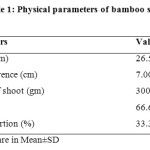 |
Table 1: Physical parameters of bamboo shoots Click here to View table |
Chemical and nutritional composition
Quality evaluation of bamboo shoots was also affirmed in terms of chemical analyses of constituents such as percent moisture, ash, protein, fat, fiber, NDF, ADF, lignin, acidity, total sugar, reducing sugars, non-reducing sugars besides TSS and ascorbic acid. In Table 2 the values for nutritional and chemical constituents are shown. Dendrocalamus hamiltonii has 91.06 per cent moisture, ash (0.81), protein (3.50), fat (0.29) and, fibre 1.50 per cent. Whereas, other constituents of fibre i.e. NDF, ADF and lignin has the value 2.54, 2.08 and 0.49 per cent, respectively. Bhatt et al., (2005) had earlier reported 94.70 per cent moisture content which was on the higher side when compared with present values. The results of the present study are close to the values reported by Kumbhare & Bhargava, (2007) who reported 0.90 per cent ash in Bambusa nutans and 0.80 per cent in Dandrocalamus asper and Bambusa vulgaris. Satya et al., (2010) reported these values to be on the higher side i.e. 3.90 per cent. Bhatt et al., (2003) had also attained higher value (4.16 %) in Bambusa vulgaris. This variation could be due to the inherent genetic variations of the bamboo varieties. The results are in close agreement with Sharma et al., (2004) who reported the fat content to be 0.20 per cent whereas, Anonymous, (2004) reported 0.50 per cent fat content which is considerably on higher side of the present study whereas, Kumbhare & Bhargava, (2007) reported 0.76 per cent crude fibre which are on the lower ebb. The results are in line to Nirmala et al., (2008) who reported (2.65 %) NDF, (2.15%) ADF, and (0.56%) lignin in bamboo shoots. The results obtained are also in close agreement with Devi & Singh, (1986) who reported 0.20 per cent acidity in bamboo shoots.
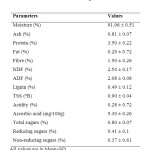 |
Table 2: Chemical and nutritional composition of bamboo shoots Click here to View table |
TSS was calculated as 0.900 B in the shoots. Acidity was calculated as 0.28 per cent and ascorbic acid was calculated as 5.30 mg/100g. In sugars, the values were calculated as 0.80, 0.41 and 0.37 per cent for total, reducing and non-reducing sugars, respectively. Bhatt et al., (2005) reported 5.30 mg/100g ascorbic acid and thereafter, Nirmala et al. (2007) also found 3.20 mg/100g ascorbic acid in bamboo shoots. The results in the present study are in accordance with these findings. Kumbhare and Bhargava (2007) reported (1.05 %) reducing sugars in Bambusa nutans. The difference in values is due to varietal difference. We had also evaluated 4 varieties of bamboo earlier and the non-reducing content was estimated at 0.37, 0.43, 0.37 and 0.38 for Phyllostachys pubescens, Dendrocalamus asper, Dandrocalamus hamiltonii and Bambusa bambos, respectively thus corroborating the percent findings.
The chemical analysis also revealed the potency of the bamboo shoots as food items because of richness in minerals especially Ca, Na, K, P and Mg and the results are shown in Table 3 that calcium content of the shoot is 15.00 mg/100g and that of copper, sodium, potassium, phosphorous, magnesium is 0.29, 4.80, 533.00, 61.00 and 3.90 mg/100g respectively. Whereas, for the selenium is 6.80 µg/100g. Earlier Jetvig, (2007) had analyzed bamboo samples for their mineral composition and reported values for calcium (10mg), magnesium (2mg), phosphorus (45mg), potassium (402mg) and sodium (3mg). The slight differences in the values could be attributed to varietal difference and agro-climatic conditions in which the plants are grown. After having evaluated various nutritional attributes of this particular species of bamboos, it can be concluded that this can be recommended for eating purposes because it is rich in fibre and low in fat and therefore, can be useful for diabetic and cardiac patients.
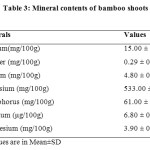 |
Table 3: Mineral contents of bamboo shoots Click here to View table |
Preparation of some value added products using Dendrocalamus hamiltonii.
This variety is locally available in plenty and generally goes waste because of lack of processing knowledge. Presently, an effort was made to standardize different recipes for various value added products viz. chukh, chutney, preserve, nuggets, crackers and candy by using bamboo shoots and was analyzed for their nutritional parameters. The results of the various attributes of the above mentioned six novel products made using Dendrocalamus hamiltonii variety of bamboo shoots is given in Table 4 (a & b) and the results of the organoleptic evaluation shown in Table 5.
Bamboo Preserve
Fruits are preserved globally in this form. Fruit preserves are the fruits or vegetables, which have been prepared for long term storage. The preparation traditionally involves sugars or honey as sweetening agents. Bamboo shoot preserve was prepared by slow method and evaluated for their nutritional as well as sensory perception. Pertinent results are presented in Table 4. The values for total soluble solids in the preserve were estimated to be 70° Brix. Whereas, acidity was calculated as 0.70 percent, ascorbic acid content was 8.51 mg/100g. As far as sugar content of preserve is concerned, total sugar was estimated as 46.51 per cent while reducing sugar content was 23.11 per cent and non-reducing sugars were 22.23 per cent. Products were subjected to organoleptic evaluation by a panel of 10 judges and analyzed for various sensory attributes like colour, flavour, taste, texture and the overall acceptability results are depicted in Table 5. A glance at Table showed that the color is an indirect indication of flavor and taste and the preserve bagged the value as 7.00. Other sensory attribute is flavor which is one of the most complex sensations that forms the basis for selection of food. The same Table reflects the flavor scores for preserve to be 7.50. Taste, which is a blend of flavor and aroma and its value, was calculated as 7.50 for preserve. Texture is assessed by finger feel such as firmness and softness. The textural score of 8.00 was obtained by the product.
Bamboo Candy
Candy is a confectionery item coated with sugar. It is generally made from fruits by boiling with concentrated sugar solution. It is also a method of preserving fruits for long term like preserve. An effort was also made to prepare candy out of Bamboo shoots. The candy was also evaluated for objective as well as subjective evaluation. The results are highlighted in Table 4. The values estimated for TSS (oBrix), acidity percent and ascorbic acid mg/100g were 68.00, 0.66 and 8.09, respectively. For sugars, the calculated values were 66.40% for total sugars, 29.30% for reducing sugars and 35.24% for non-reducing sugars. As far as the sensory scores for candy are concerned, the scores were 7.50, 7.00, 8.00 and 7.83 for color, flavor, taste and texture, respectively. The overall acceptability scores for candy were 7.58. The results are in conformation with Awasthi (2007) who reported 23.16% reducing sugar. The variation may be due to original difference in raw materials.
Bamboo Chutney
Chutney is a relish used along with main course. Effort was made to prepare chutney by blending the shoots in a mixer just to get homogenized pulp, concentrated by the addition of spices etc. till the time to get the desired consistency. This product was also tested objectively and subjectively.
The bamboo shoot chutney was analyzed for nutritional parameters. The results have been discussed in Table 4. Total soluble solids in chutney were estimated as 60oB. Acidity per cent was 0.66. The ascorbic acid content of chutney was 1.04 mg/100g. For sugars, the total sugars content was 57.65%. Reducing sugars and non-reducing sugars were calculated as 22.71 and 27.92%, respectively. Awasthi, (2007) prepared Lesura chutney and observed almost similar values for acidity and ascorbic acid. Pleasing look of the food promotes the flow of digestive juice and thereby, the color of the product should be appealing to the judges. The mean score for color for bamboo chutney was obtained as 6.50. The response for flavor is given by taste buds since it’s a combination of taste and aroma. The maximum value for flavor was 6.83. From the acceptability point of view, the parameter taste has its own criticality that depends upon the ingredients of a particular food. The value of 7.50 for textural score for bamboo chutney was significant. The value attained for taste for bamboo chutney is 7.00. However, overall acceptability preference for chutney was established as 6.95.
Bamboo Chukh
Chukh is a speciality of Chamba district of Himachal Pradesh (India). It is basically prepared by using red chili with citrus juice. Presently, an effort was made to add Bamboo chunks just to improve the nutritive value and add variety. When the Chukh was analyzed on the day of processing, acidity per cent was estimated to be 4.30, ascorbic acid was calculated as17.00 mg/100 g. Total reducing and non-reducing sugars were calculated as 27.61, 12.21 and 14.63%, respectively. Another parameter which was estimated in Chukh was per cent salt which came out to be 17.11. A glance at Table 5 reveals the organoleptic scores obtained for chukh. The scores bagged for color flavor, taste and texture were 8.00, 7.50, 7.83 and 8.00 respectively. Overall acceptability score for Chukh was 7.83. This gives credence to the product with new dimensions. Earlier also Negi, (2007) calculated similar results for Chukh.
Bamboo Crackers (Papad)
Papad is a famous snack product in India. It is generally roasted or fried and served with all traditional and modern Indian meal. The product was prepared with bamboo shoots and evaluated for its nutritional properties as per Table 4 (b). The values for protein, fat and fiber were 2.35, 7.88 and 3.90% respectively. The moisture content of final product cracker (papad) was 18.43% indicated that product is safe for long storage. Total carbohydrate and total ash content were 65.88 and 2.04% also showed higher nutritive value of the product. The results from the sensory penal scores showed the acceptability of the crackers to the consumers in Table 5. The highest scores for flavor, texture and overall acceptability of the final product is 8.00. The product tasting panels showed very much consumer acceptability of the prepared bamboo product.
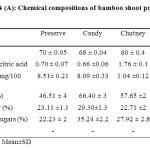 |
Table 4 (A): Chemical compositions of bamboo shoot products Click here to View table |
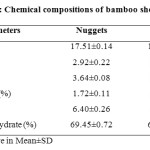 |
Table 4 (B): Chemical compositions of bamboo shoot products Click here to View table |
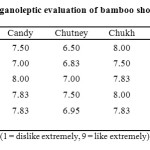 |
Table 5: Organoleptic evaluation of bamboo shoot products: Click here to View table |
Bamboo Nuggets
Nuggets are also a traditional variety of food product also known as wadia. This product is mostly famous in the northern region of India. It is generally roasted and then boiled in a curry and served with main meal. This novel bamboo incorporated product was evaluated for its nutritional properties as per Table 4(b). The values for fiber, and protein were 6.40 and 2.92% respectively. The fat content and ash content of final product was 3.64% and 1.72% indicated that product is healthier. Total carbohydrate value of prepared product was 69.45%. The results from the sensory penal scores showed that the prepared product was acceptable by consumers in Table 5. The highest scores for taste and texture was 8.00 and 7.85 respectively. The overall acceptability of the final product was 7.50 at nine point hedonic scale.
Conclusion
The high nutritive value with good source of mineral and fiber content of fresh bamboo shoots need to be explored for their potential for edible purposes. Since bamboo shoots are available for a limited period, different edible products were formulated. The products made were very good in taste as well as from the nutritional point of view. Value addition of these available products in market having bamboo component increases their marketability potential as novel products. This is the initial study for the development of bamboo shoot products and its analyses. But it has a vast potential to be developed as a novel, innovative and promising food industry in India. In very near future, Bamboo shoots are getting more popular as healthy and nutritionally supplemented edibles among the communities both rural and urban. Many different food products can also be made with the incorporation of bamboo shoots.
Acknowledgement
Authors are thankful to the Director, CSIR- Institute of Himalayan Bioresource Technology, for providing necessary facilities and continuous support to carry out the research work. This manuscript bears the CSIR- IHBT publication no 3494.
References
- Anonnymous., Cyanogenic glycosides in cassava and bamboo shoots, a human health risk assessment. Technical report series no. 28. Food Standards Australia New Zealand. (2004).
- AOAC., Official Methods of Analysis. Association of Official Analytical Chemists. 11th edition Washington D C USA. P-240 (1990).
- AOAC., Official Methods of Analysis. Association of Official Analytical Chemists. 11th edition Washington D C USA. P-240 (2005).
- Awasthi M., Nutritional and Product development studies on Kachnar (Bauhinia variegate) and Lesora (Cordia dichotoma). M.Sc. Thesis. CSK-Himachal Pradesh Krishi Vishawvidyalaya, Palampur (2007).
- Bhatt B.P., Singh K. and Singh A., Nutritional values of some commercial edible bamboo species of North Eastern Himalayan region, India. Journal of Bamboo and Rattan. 4, 896-898 (2005).
CrossRef - Bhatt B.P., Singha L.B., Singh K. and Sachan M.S., Commercial edible bamboo species and their market potentiality in three Indian tribal states of North Eastern Himalayan region, Journalof Bamboo and Rattan 2 (2), 111–133 (2003).
CrossRef - Devi S.P. and Singh H.T., Studies on the chemical and nutritional changes of Bamboo shoots during fermentation. J. Food Sci. Tech. 23(6), 338-339 (1986).
- Gupta V.K., Kumria R., Garg M. and Gupta M., Recent updates on free radicals scavenging flavonoids: An overview. Asian J. Plant Sci. 9, 108-117 (2010).
CrossRef - ISFR – Indian State of Forest Research (2011) http://pib.nic.in/newsite/erelease.aspx?relid= 81760.
- Jetwig S. (2007). www.Bamboo shoots.com
- Kumbhare V. and Bhargava A., Effect of processing on nutritional value of central Indian Bamboo shoots. Part-1. J. Food Sci. Tech. 44, 29-31 (2007).
- Mazumdar, B.C. and K. Majumder, 2003. Methods on Analysis of Fruits. University Delhi. Vol. IV, p: 297. college of Agriculture, Calcutta University. 108-109.
- Negi P., Standardization of “Chamba Chukh”- A Hot chilli sauce recipe of Himachal Pradesh. M.Sc. Thesis CSK-Himachal Pradesh Krishi Vishawvidyalaya, Palampur (2007).
- Nirmala C., David E. and Sharma M.L., Changes in nutrient components during aging of emerging juvenile Bamboo shoots. Int. J. Food Sci. Nut. 53, 1-7 (2007).
- Nirmala C., Sharma M.L. and David E., A comparative study of nutrients components of freshly harvested, fermented and canned Bamboo shoots of Dendrocalamus giganteus Munro. J. Amer. Bamboo Soc. 21, 33-39 (2008).
- Pandey A.K., Ojha V. and Choubey S.K., Development and shelf-life evaluation of value added edible products from bamboo shoots. Amer. J. Food Tech. 7, 363-371 (2012).
CrossRef - Pandey A.K., OjhaV., Yadav S. and Sahu S.K., Phytochemical evaluation and radical scavenging activity of Bauhinia variegata, Saraca asoka and Terminalia arjuna barks. Res. J. Phytochem. 2, 89-97 (2011).
CrossRef - Ranganna S., Handbook of analysis and quality control for fruit and vegetables products. 3rd edition. Tata McGraw-Hill (1995).
- Satya S., Bal L.M., Singhal P. and Naik S. N., Bamboo shoot processing: food quality and safety aspect (a review). Trends in Food Science & Technology, 21 (4), 181–189 (2010).
CrossRef - Sharma M.L., Nirmala C. and David R.E., Variations in nutrient and nutritional components of juvenile bamboo shoots. Panjab Univ. Res. J. 54: 101-104 (2004).
- Shi Q.T. and Yang K.S., Study on relationship between nutrients in bamboo shoots and human health. Proceedings of the International Symposium on Industrial Use of Bamboo, December 7-11, 1992, International Tropical Timber Organization and Chinese Academy, Beijing, China pp: 338-346 (1992).
- Visuphaka K.. The role of bamboo as a potential food source in Thailand. Proceedings of the International Bamboo Workshop, October 6-14, 1985, Recent Research on Bamboos, Hangzhou, China, pp: 301-303 (1985).

This work is licensed under a Creative Commons Attribution 4.0 International License.





